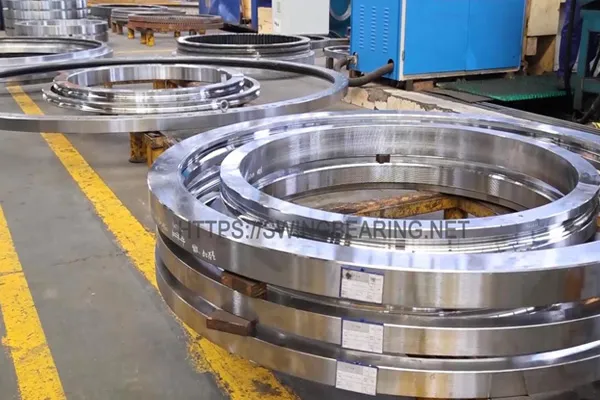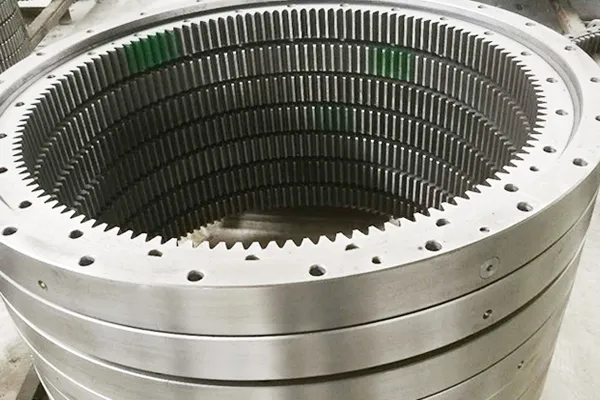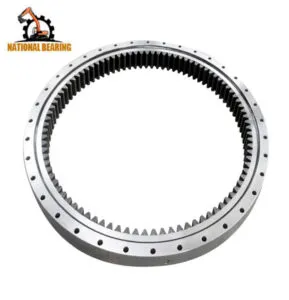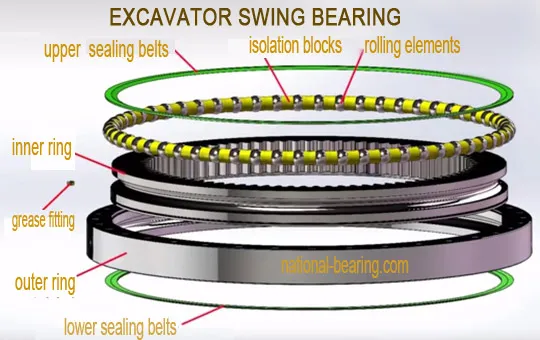
Odhalenie skrytej sily: Lokalizácia otočného krúžku v rýpadle
Otočný krúžok, známy aj ako výkyvné ložisko, je dôležitou súčasťou rýpadla. Nachádza sa v základni hornej konštrukcie rýpadla a umožňuje otáčanie hornej konštrukcie vzhľadom na podvozok. Otočný krúžok je zodpovedný za prenos hmotnosti hornej konštrukcie a kopacích síl na podvozok. Umožňuje tiež výkyv rýpadla zo strany na stranu.

Otočný krúžok rýpadla
Stránka otočný krúžok, a crucial component in an excavator, plays a pivotal role in enabling the machine’s upper structure to rotate smoothly upon its lower structure. Understanding its location is essential for maintenance and repair purposes.
Výkyvné ložisko sa zvyčajne nachádza na základni hornej konštrukcie rýpadla, kde sa spája so spodnou konštrukciou. Pozostáva z dvoch sústredných krúžkov, z ktorých jeden je pripevnený k hornej konštrukcii a druhý k spodnej konštrukcii. Krúžky sú oddelené radom valivých prvkov, ako sú guľôčkové ložiská alebo valčeky, ktoré uľahčujú otáčanie.
Ak chcete nájsť výkyvné ložisko, začnite identifikáciou hornej a dolnej konštrukcie rýpadla. Horná konštrukcia je časť, v ktorej sa nachádza kabína, výložník a rameno, zatiaľ čo spodná konštrukcia zahŕňa pásy alebo kolesá a podvozok.
Po identifikácii hornej a dolnej konštrukcie vyhľadajte miesto ich spojenia. Zvyčajne je to kruhový alebo šesťuholníkový otvor v strede hornej konštrukcie. Otočný krúžok sa nachádza v tomto otvore.
V niektorých rýpadlách môže byť výkyvné ložisko čiastočne alebo úplne uzavreté ochranným krytom. Tento kryt slúži na udržiavanie čistoty a mazania otočného krúžku, čím sa predlžuje jeho životnosť. Na získanie prístupu k otočnému krúžku môže byť potrebné odstrániť kryt.
Umiestnenie otočného krúžku sa môže mierne líšiť v závislosti od konkrétneho modelu a výrobcu rýpadla. Vo všeobecnosti sa však nachádza na základni hornej konštrukcie, kde zabezpečuje stabilné a spoľahlivé spojenie medzi hornou a dolnou konštrukciou.
Pochopenie polohy otočného krúžku je kľúčové pre údržbu a opravy. Pravidelná kontrola a mazanie otočného krúžku sú nevyhnutné na zabezpečenie jeho správnej funkcie a zabránenie predčasnému opotrebovaniu alebo poruche. Ak technici vedia, kde nájsť otočný krúžok, môžu tieto úlohy vykonávať efektívne, čím sa maximalizuje výkonnosť a životnosť rýpadla.
Výkyvné ložisko, kľúčová súčasť rýpadla, sa nachádza na základni hornej konštrukcie, kde sa spája so spodnou konštrukciou. Toto strategické umiestnenie umožňuje plynulé a efektívne otáčanie hornej konštrukcie, čo umožňuje rýpadlu vykonávať širokú škálu úloh.
Otočný krúžok sa skladá z dvoch hlavných komponentov: vnútorného ozubeného kolesa a vonkajšieho ozubeného kolesa. Vnútorné ozubené koleso je pripevnené k hornej konštrukcii, zatiaľ čo vonkajšie ozubené koleso je pripevnené k spodnej konštrukcii. Keď obsluha rýpadla aktivuje otočný motor, vnútorný prevod sa otáča, poháňa vonkajší prevod a spôsobuje otáčanie hornej konštrukcie.
The slew ring plays a vital role in the excavator’s functionality. It provides a stable and reliable connection between the upper and lower structures, ensuring smooth and precise rotation. Without a properly functioning slew ring, the excavator would be unable to perform its intended tasks effectively.
Umiestnenie otočného krúžku na základni hornej konštrukcie je nielen praktické, ale aj výhodné. Toto umiestnenie umožňuje ľahký prístup počas údržby a opráv, čím sa minimalizujú prestoje a zabezpečuje sa nepretržitá prevádzka rýpadla.
Okrem svojej hlavnej funkcie prispieva otočný krúžok aj k celkovej stabilite rýpadla. Tým, že poskytuje pevné spojenie medzi hornou a dolnou konštrukciou, pomáha rovnomerne rozložiť hmotnosť rýpadla a zabraňuje jeho prevráteniu počas prevádzky.
Okrem toho umiestnenie otočného krúžku v základni hornej konštrukcie umožňuje inštaláciu ďalších komponentov, ako sú hydraulické vedenia a elektrické rozvody. Tieto komponenty sú nevyhnutné pre prevádzku rýpadla a sú pohodlne vedené cez otočný prstenec, čím sa zabezpečí ich ochrana a funkčnosť.
Na záver možno konštatovať, že otočný krúžok je kritickým komponentom rýpadla, ktorý sa nachádza na základni hornej konštrukcie. Jeho strategické umiestnenie umožňuje plynulé otáčanie, zabezpečuje stabilitu a uľahčuje inštaláciu základných komponentov. Pochopenie funkcie a významu otočného krúžku je kľúčové pre zabezpečenie efektívnej a spoľahlivej prevádzky rýpadla.
The slewing ring is a vital component in an excavator, playing a pivotal role in enabling the upper structure to rotate smoothly upon the undercarriage. Understanding its location, structure, and function is essential for troubleshooting common issues related to this critical part. This detailed guide will help you identify, diagnose, and resolve problems associated with the slewing ring, ensuring your excavator operates efficiently.
The slewing ring is typically situated at the base of the excavator’s upper structure, where it interfaces with the lower frame. It comprises two concentric rings: one fixed to the upper structure and the other to the lower frame. Between these rings are rolling elements, such as ball bearings or rollers, that facilitate the rotation of the upper structure.
To access the slewing ring, it is necessary to remove the upper structure from the undercarriage. This involves several steps:
Once the upper structure is detached, the slewing ring becomes visible as a large, circular component located at the base of the upper frame.
The primary function of the slewing ring is to facilitate the rotation of the excavator’s upper structure relative to its undercarriage. This allows the operator to maneuver the boom, arm, and bucket with precision, enhancing the excavator’s versatility and efficiency. The slewing ring must withstand significant loads and stresses during operation, making its proper maintenance and functioning critical.
One of the most common issues with the slewing ring is excessive wear. This can result from various factors, including heavy usage, inadequate lubrication, and contamination. Symptoms of excessive wear include:
To diagnose excessive wear, perform the following checks:
If excessive wear is confirmed, take the following steps:
Proper lubrication is crucial for the smooth operation and longevity of the slewing ring. Inadequate or incorrect lubrication can lead to increased friction, overheating, and premature failure.
Signs of lubrication problems include:
To resolve lubrication issues:

Otočné ložisko rýpadla
Bearing failure in the slewing ring can have severe consequences, including total operational shutdown. This issue can be caused by various factors, including overloading, poor maintenance, and manufacturing defects.
Symptoms of bearing failure include:
If bearing failure is suspected:
Regular monitoring and maintenance are crucial for preventing issues with the slewing ring and ensuring its optimal performance.
Perform scheduled inspections to identify potential issues before they become severe:
Ensure that operators and maintenance personnel are adequately trained:
The slewing ring is a critical component of an excavator, enabling the upper structure to rotate smoothly upon the undercarriage. Understanding its location, structure, and function is essential for troubleshooting common issues and ensuring optimal performance. By regularly inspecting, maintaining, and addressing issues such as excessive wear, lubrication problems, and bearing failure, you can prolong the life of the slewing ring and enhance the overall efficiency and reliability of your excavator.
By following these detailed maintenance practices, you can ensure that your excavator’s hydraulic system remains in top condition, providing reliable performance and longevity. Regular monitoring, proper lubrication, and timely replacement of worn components are key to preventing common issues and maintaining the efficiency of the slewing ring.

Štruktúra otočného krúžku
1. Kde sa v rýpadle nachádza otočný krúžok?
- Otočný krúžok sa nachádza medzi hornou a dolnou konštrukciou rýpadla.
2. Aká je funkcia otočného krúžku v rýpadle?
- Otočný krúžok umožňuje otáčanie hornej konštrukcie rýpadla vzhľadom na spodnú konštrukciu.
3. Aké rôzne typy otočných krúžkov sa používajú v rýpadlách?
- V rýpadlách sa používajú dva hlavné typy otočných krúžkov: otočné krúžky s guličkovými ložiskami a otočné krúžky s valčekovými ložiskami.
Otočný krúžok, známy aj ako výkyvné ložisko, je dôležitý komponent umiestnený v základni hornej konštrukcie rýpadla. Poskytuje oporu a umožňuje plynulé otáčanie hornej konštrukcie na spodnej konštrukcii, čo umožňuje rýpadlu vykonávať kopacie a výkopové práce s presnosťou a účinnosťou.